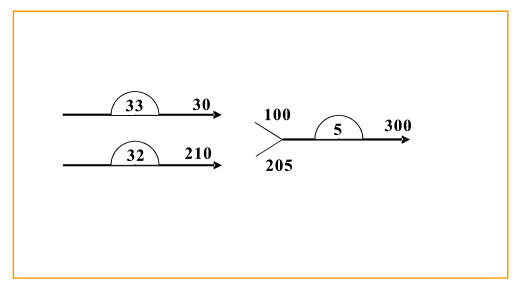TRANSYT 16, 15 and 14: Although the below (described for TRANSYT 13) also applies to TRANSYT 16, 15 and 14, the use of OD Matrices to allocate traffic to the network should ensure the consistency of the flows within each OD Matrix ‘zone’. Inconsistency of flows at the boundary of two OD Matrices however can still occur and should be checked for. The same scaling of flows occurs (as described below) where inconsistencies are present.
TRANSYT 13, and TRANSYT 12: Typically the flows specified in TRANSYT can be inconsistent simply because they are often obtained from on-street measurements made at different times. TRANSYT automatically increases or decreases by the same proportion ALL source (upstream) link entry flows so that their combined value is the same as the link’s “Total Flow”. This effectively means that the upstream entry flows are not used directly within TRANSYT and are simply defining the PROPORTION of the total flow for that link that is coming from the specified source (upstream) link, e.g. doubling all the source entry flows on a particular link would produce the same TRANSYT results.
TRANSYT works out what factor to multiply the total flow on a source link by, in order to provide the downstream link with the right flow (based on the relevant proportion of the Total Flow for the downstream link).
Both TRANSYT 12 and TRANSYT 13 indicate when discrepancies occur, but show the data slightly differently and have different ‘trigger’ points. e.g.
TRANSYT 12: If a link U flows into several downstream links, TRANSYT checks to see if the flow to any individual link is greater than twice the total flow on link U and if so produces a warning message. See the example below:
e.g. This scenario (see diagram) would produce the following warning:
LINK 5 IS MULTIPLYING UPSTREAM FLOW ON ENTRY 2 BY 327 PER CENT
TRANSYT 13: If a link U flows into several downstream links, TRANSYT checks to see if the flow to any individual link is greater than 125% of the total flow on link U and if so produces a warning message. Therefore, please note how TRANSYT 13 more-readily produces warnings of this type.
On the Task List: Link 33: downstream flow apparent gain = 68.36 (327.87%)

TRANSYT does NOT check to see if the sum of all flows out of U is greater than twice the reported flow on U. Therefore, whether a warning is given will depend on the total flow for U, and so it’s possible that for a given downstream link D, a warning may get written for some upstream links but not others. N.B. TRANSYT only stops a run and produces an error message (instead of a warning) when any upstream flow is scaled by a factor of 6000%!TRANSYT is multiplying link 33 total flow by 3.27 in order that it provides link 5 with the traffic flow it is expecting, i.e. 100 / (100 + 205) * 300. N.B. The reference to ENTRY 2 in the error message is simply referring to the second defined upstream link of Link 5 (in this case Link 33) and is NOT a link number.